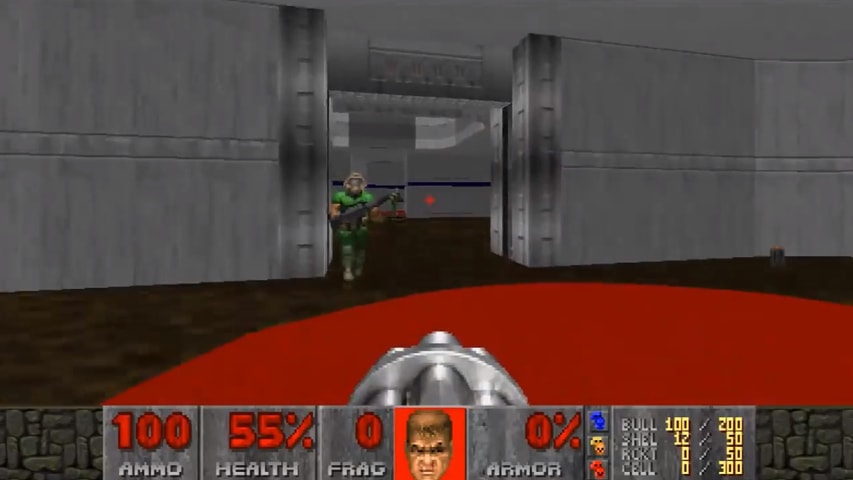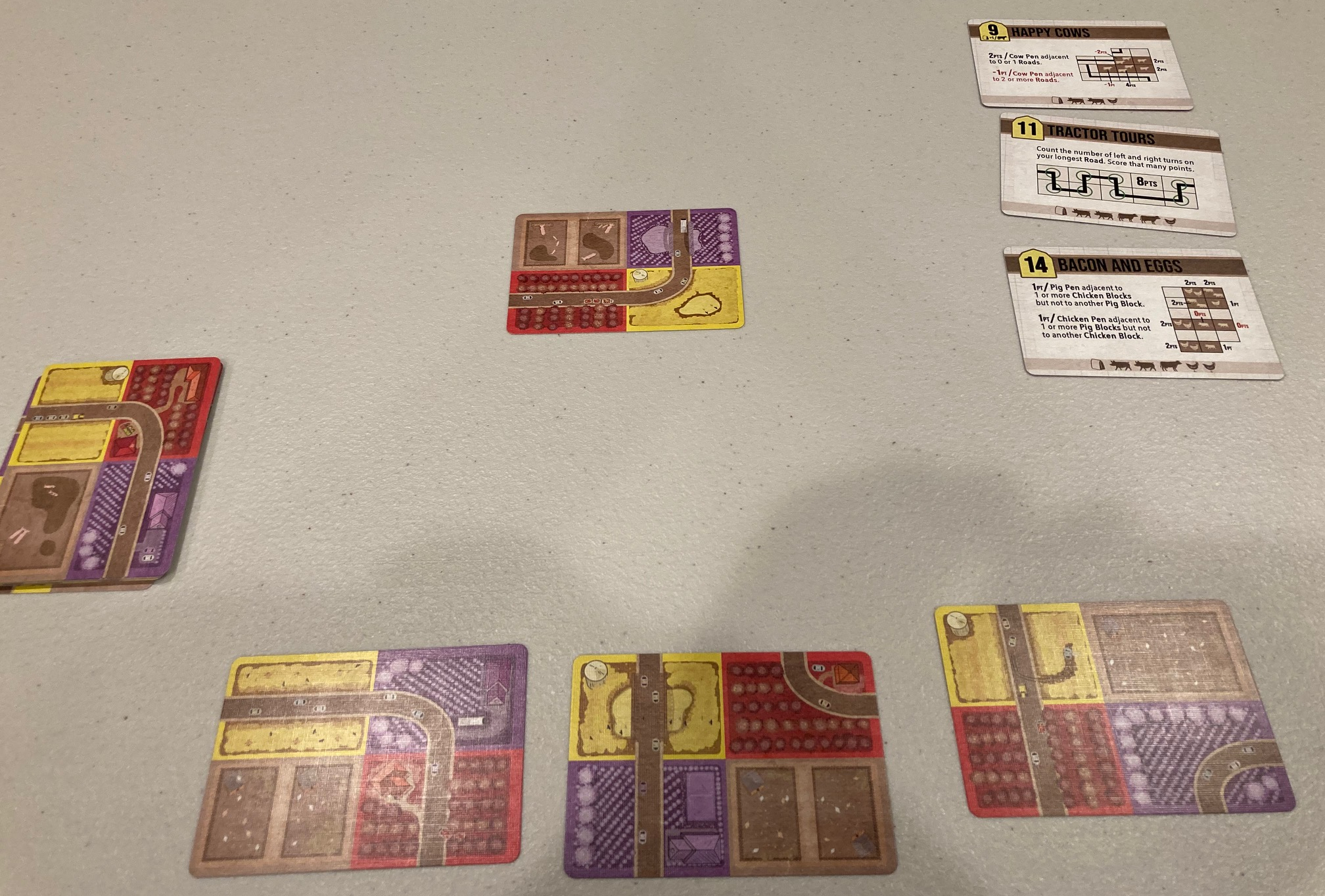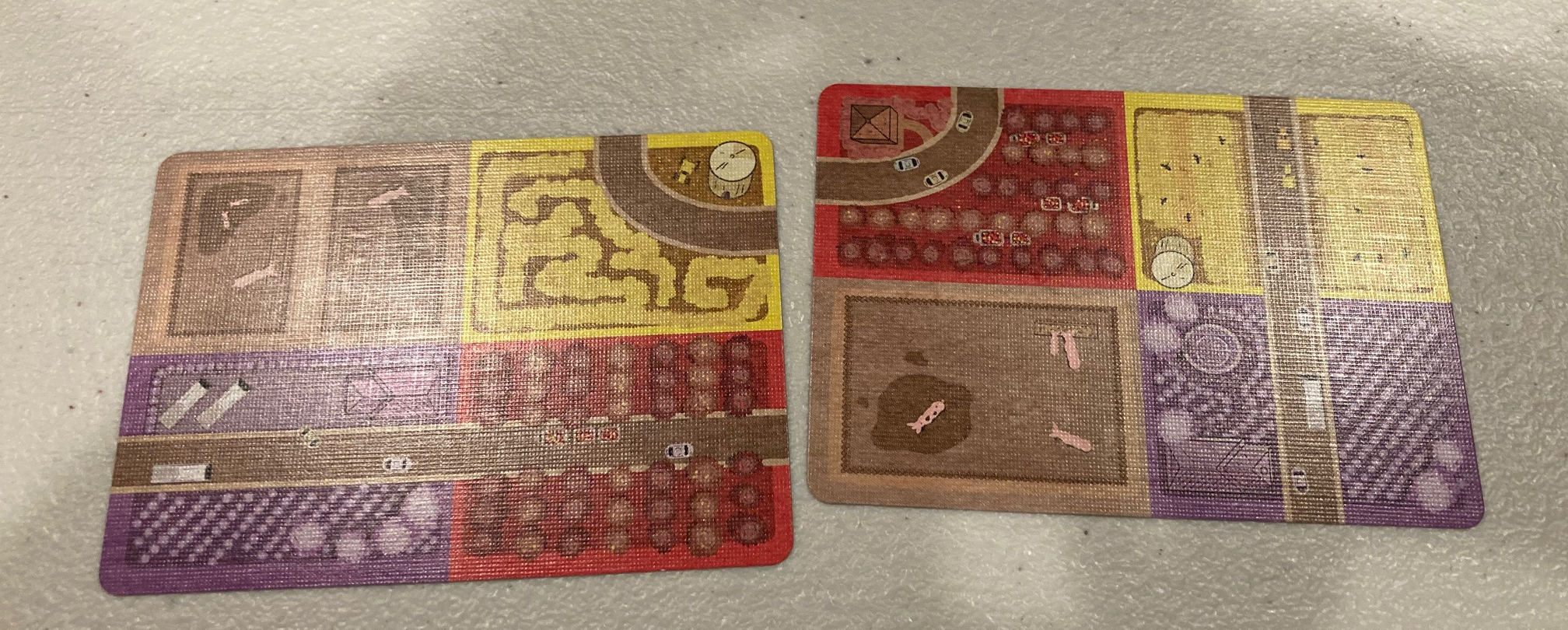Madga is solitaire only card game that was Kickstarter back in October 2020. It delivered to Kickstarter backers just (well, to me at least) yesterday: March 24, 2021. It promised delivery in July 2021 … yes, it was 1.5 months early! Huzzah to the makers!

As a Kickstarter backer, I also got a little cloth patch (see above). Neato!

The reason I picked up Magda was because of the art and the theme. I do like the art and the theme! See above. It also happens to be a pretty quick game: only 15 minutes (although I have had much shorter games, see later below).

I was a little surprised how small the box was (see above for scale)! Luckily, the cards are the same size as the box, so the cards are bigger than you expect.

Let’s take a look at this weird little solo card game …
Components

The game is all cards! See above. The cards look really nice and I do like the art. The cards are all easy to read (see below). Unfortunately, they are not linen-finished: this is unfortunate because you handle the cards quite a bit (especially the player cards).
You can see from the cards that the game looks kind of creepy … and it is! You are travelling in space, trying to get home, and the jealous computer Magda is trying to stop you! Overall, the components look really nice: this is why I got the game.

Rulebook
The rulebook is a quad-fold pamphlet. I usually hate pamphlets, but I gave Agroplis a pass on this because it was a nice little rulebook. Unfortunately, the Madga one isn’t nearly as good and it suffers from being a pamphlet.
I will admit the rulebook does a decent job with set-up: I got going right away on that! It was pretty clear how to set-up the game.
The object of the game is explained fairly well, as is the basic gameplay. But this is where a lot of questions start: how can I lay out the travel cards? Do I need one travel card per planet? Can travel cards cascade? Do I have to put them out a certain way? There is some more discussion in the “gameplay tips and notes”, but I feel like that should be covered HERE IN THE RULES (not tips).
Above, you can see the discussion of how Magda plays.
I should give props to this pamphlet: the text is big enough to read, it uses colors well to emphasize points, and it shows necessary pictures. And you can get going with it. Like I said, I was up and playing the game pretty quickly.
So, the graphic design is good and its fairly readable, BUT the rulebook just doesn’t cover any edge conditions or anything beyond the most basic questions of ruleplay! I had some questions about gameplay:
- Do you have to fulfill a mission ONLY off the arrows from that part of the manifest card?
- What does the topology of the travel?
- Why are there so many travel cards?
- Does the planet matter?
I made it through and was able to play a few games, but I had to guess on a few of these things.
The rulebook was okay: the design and readability were good, but it didn’t discuss some basic questions I had: some rules seemed to be missing.
Set-Up

Initial set-up is real easy! You set up three queues of cards (for good or “pilot” cards), a deck of Magda cards (or “Bad News” cards), your ship (with a stern and bow), and your initial Manifest which describes the three missions you must complete to win. It looks pretty nice: see above.
The manifest (see above) is the most important card in the game: it tells you what your 3 missions are! In order to win, you must complete all 3 missions and then go home (playing the HOME card to the middle). Each mission is made up of a planet, mission, and asset. If you can place all three together (as described on the manifest), you have completed a missions! The planets, missions, and assets all come from the Pilot deck or one of your three queues.
Whenever you play a planet, mission, or asset down, you have to play a Magda card and see what her reaction is. She’s the bad guy: her cards are the “Bad News” cards: see below.

Gameplay

To play, you cycle through your Pilot deck, either placing a card on the board or in one of your three queues (see above). You can always choose to play the top card of a queue instead of the top card of your Pilot deck. Usually when you play to the board, a Magda card comes out, so you don’t want to do that unless you have to! You get cards into your queues hope for the cards you want.
The game moves quickly and is usually over within 15 minutes.
Thoughts
First off, I love the art style. The Mission, Planet, and Asset cards (see above) remind me of the covers of old-style Sci-Fi paperback novels. And the art is very evocative! The art of the Magda cards (or “Bad News”) is just creepy!
The rulebook could be better, but it at least does a good job explaining basic gameplay. You can muddle through the edge conditions and play.

Unfortunately, the game is pretty random. Take a look at the card above: if you just happen to play this as your last card, you lose!!!! It doesn’t matter what you did the rest of the game. And, unfortunately, a lot of the Magda bad news cards are just as unforgiving:

In my first game, I lost because I had the therapist out and the “She Messed With My Head” came out. I just lost! It was very unsatisfying.
The amount of randomness in this game might drive you a little crazy. Sometimes it’s just no fun, as all you can is play cards, and there aren’t a lot of ways to mitigate the Magda cards: You can get one of the 4 good cards in play, and you can “cap” mission-triads to make sure Madga can’t affect them. But that’s kind of it: you don’t “really” have a lot of choices in the game.
After my first few plays, I was almost done with the game! It was too random! Not enough choice, and not enough ways to mitigate the Magda cards. I was almost ready to be done and give this game a 3.
However, read on.
Strategy … of a Kind

See above for a winning game. Was this all luck? No, but there are two things working in your favor:
- There is no penalty for going through all your Pilot cards! Once you do that, you simply take all three queues back up, shuffle them, and start another 3 queues! WHAT THIS MEANS: if you want a card, simply keep cycling through the deck until you find it. In other words, there’s almost no reason for the three queues, you can find the 3 cards you want (Mission, Planet, Asset) by just cycling through the deck.
- You can figure out what card is on the bottom of the deck when you cycle! As you cycle through your deck, you can figure out (by process of elimination) what the very last card is. WHAT THIS MEANS: When you need to cap a deck to keep Magda from ruining a Mission/Planet/Asset triad, you can predict what the card is! When you uncap to try to win the game, you WANT to play the cap card, otherwise you have to play 2 Magda cards! To avoid that, you can simply force the cap card to be what you want (by cycling through the deck a few times)!
With those two realizations, you can play a winning game and at least mitigate a lot of randomness. In fact, the very first thing you should do is cycle through the deck and get all 4 “good” cards out:
Basically, you can either spend your first turn “cycling though the deck” to find the 4 cards … or just put them out at the start of the game. Remember, this works because Magda doesn’t play any bad news cards until you play something (Planet/Mission/Asset) to the middle .. . you can cycle your deck infinite times looking for the cards you want without repercussions.
Once you put all this together, the game is a little more playable, but it’s more work as you “cycle” cards. By getting the 4 Good cards out, you can decide when to use them, you can decide when to cap and what to cap with, you can decide which missions to go after. When Magda deals you some randomness, at least you have some choice.
It sort of reminds me of variants of Solitare when you cycle through your draw pile … “I know there was a Queen in there…”
Conclusion
This game is just okay at best. Using the observations from the section above, you can do some things to mitigate the randomness of the game. Unfortunately, there’s still quite a bit of randomness, and it can be infuriating. I will say that I do like the art, and Magda has the advantage that the game is simple and short. A lot of people don’t care if a game is too random as long as it is short: I am not one of those people, but you may be! Is that’s the case, maybe Magda will be for you.
I could see playing Magda to pass some time.
To be clear, Magda is a game and it is playable and I would play it again. Compare this The Umbrella Academy which is unplayable and I never want to see it again. But, if you are looking for a fun, thematic, small solo card game, either take a look at our review of The Dead Eye or one of our Top 10 “Small” Cooperative Games for better recommendations.












:strip_icc()/pic5617866.jpg)




:strip_icc()/pic5779755.jpg)


























:strip_icc()/pic3302249.png)
:strip_icc()/pic3281189.jpg)
:strip_icc()/pic2545662.jpg)
:strip_icc()/pic2093240.jpg)
:strip_icc()/pic4231262.png)




:strip_icc()/pic1286586.jpg)
:strip_icc()/pic832891.jpg)
:strip_icc()/pic5591026.jpg)
:strip_icc()/pic5939982.jpg)




:strip_icc()/pic3763540.jpg)
:strip_icc()/pic3901402.jpg)
:strip_icc()/pic5253984.jpg)
/pic5253985.jpg)

